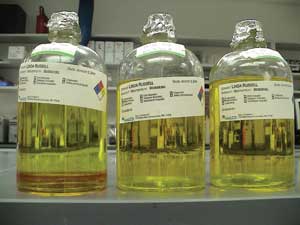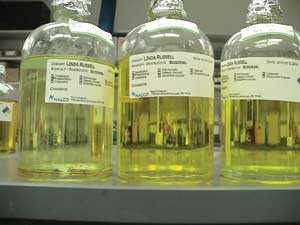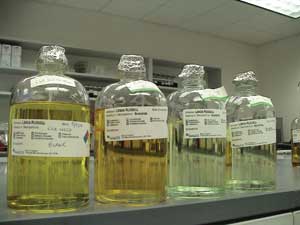Preventing Sediment Formation In Stored Biodiesel Fuel Blends







November 13, 2008
BY Kim Peyton, Tim McGinnis and Phil Bureman
Preventing fuel-related problems before they develop, whether during the production, transportation, storage or combustion of fuel, is a goal of everyone working in the fuel industry. Recent testing of biodiesel blends by ASTM D 4625, a long-term storage stability test method, has identified the formation of sediment in stored B5 and B20 blends. The sediment components have been analyzed and are shown to originate from the reaction of oxygen in the air with unsaturated methyl oleate and methyl linoleate compounds in B100. However, antioxidant addition to B100 prior to blending with ultra-low sulfur diesel (ULSD) to produce B5 and B20 biodiesel blends prevented sediment formation during long-term storage.
During the 1950s, the U.S. Bureau of Mines completed a petroleum distillate fuel storage stability study, the findings of which were published in a Western Petroleum Refiners Association report in 1956. The report showed that deposits formed in drums of fuel stored for a year at ambient temperature were equivalent in amount to deposits formed in fuel stored in bottles for 13 weeks at 38 degrees Celsius (100 degrees Fahrenheit).
In the late 1960s and early 1970s, the U.S. Navy developed a related testing program to help predict the potential for sediment formation in diesel fuel transported to remote base locations for storage and use. Since overseas fuel deliveries by ship could take months, or possibly even a year or more, a method to help determine the long-term stability of stored diesel fuel was needed. From the results of this fuel stability study, it was concluded that the amount of insoluble material formed in a week of storage at 43 degrees
Celsius (110 degrees Fahrenheit) is approximately the same as the amount formed in one month of storage at ambient temperature.
This same storage stability testing method developed by the U.S. Navy was the forerunner of ASTM D 4625 Standard Test Method for Middle Distillate Fuel Storage Stability at 43 degrees Celsius (110 degrees Fahrenheit). Today, ASTM D 4625 is used to help determine whether fuels stored for an extended time develop precipitate and gums. Precipitate and gums are both problematic in the fuel intake system of internal combustion engines, turbines, burner nozzles and other fuel delivery hardware. During engine operation, sediment carried with fuel may cause filter plugging and fuel intake system fouling. Gum accumulation in storage vessels may build to form larger deposit sites. In the fuel injection system, gum accumulation may lead to sticking of moving engine parts such as fuel pump plungers, fuel injectors and valves.
The Importance of Biodiesel Storage Stability
To help predict the storage life of B100 and biodiesel blends, the fuel industry has adopted two fairly rapid testing methods: EN 14112 (Rancimat) and ASTM D 2274, Standard Test Method for Oxidation Stability of Distillate Fuel Oil. These accelerated test methods are not designed to rate the effect of long-term storage on the potential for formation and separation of oxidized precipitate in biodiesel blends.
Although most biodiesel is used within a few weeks of production, biodiesel blends such as B5, B11 and B20 could be stored for several months. Farms, military bases, construction contractors, and facilities using emergency back-up power generators such as hospitals and electric utilities are examples of facilities where long-term storage of biodiesel blends is common. For this reason, the need to prevent degradation and sediment formation in stored biodiesel blends is essential.
Sediment Formation During Long-term Storage
In a recent study, a thick, gel-like precipitate separated in B5 and B20 biodiesel blends when stored under ASTM D 4625 conditions. However, no sediment formed in B100 when stored under the same conditions.
The oils used for biodiesel blending and testing included soy oil-based B100, mixed vegetable oil-based B100, palm oil-based B100 and ULSD. All oils were obtained from U.S.-based commercial producers. The precipitate gel formed in both B5 and B20 blends made using soy oil-based B100 and mixed vegetable oil-based B100. Sediment did not form in palm oil-based B5 and B20 or in stored B100.
The appearance of precipitate in B5 and B20 blends containing high percentages of ULSD was not expected since the blends had good Rancimat and ASTM D 2274 stability ratings.
For example, as shown on page 93, the respective Rancimat lifetime ratings of 5.1 hours, six hours and more than eight hours for the soy-based B100, B20 and B5 blends coupled with the low ASTM D 2274 deposit ratings would indicate stable biodiesel blends.
However, exposure of the B20 and B5 blends to the ASTM D 4625 110 degree Fahrenheit storage conditions produced fuel haziness after six weeks. A distinct gel-like precipitate layer formed in B20 and B5 blends after 12 weeks of storage. As shown in Figure 1, the precipitate is visible in the biodiesel samples without antioxidant addition. No precipitate formed in biodiesel blends containing 100 parts per million of antioxidant.
Analysis of Precipitate Formed in Biodiesel Blends
The precipitate gel formed in biodiesel was collected and analyzed by gas chromatography/mass spectrometry. The analyses conclusively showed that the primary components in the precipitate are organic compounds that directly resulted from the oxidative cleavage of double bonds in the fatty acid methyl ester. Examples of compounds formed included a variety of aldehydes, carboxylic acids and ketones from six to 13 carbon atoms in length. Products of ester hydrolysis were found as well. Also detected in the precipitate gel were a number of compounds known to be impurities in B100. These included glycerol, monoglycerides, diglycerides and plant sterols. Trace amounts of additional oxidized compounds were also detected. Unoxidized fatty acid methyl ester was less than 3 percent of the precipitate volume.
No single degradation species dominated the gel composition. For example, two of the more apparent species detected are azelaic acid monomethyl ester (formed by the oxidative degradation of methyl oleate) and hexanoic acid (formed by the oxidative degradation of methyl linoleate). However, oxidative cleavage can occur in any compound that contains unsaturation in the carbon chain, regardless of the chain's length or the location of the double bond. They type of polar functional group (aldehyde, acid, ketone, etc.) that can form at the point of cleavage can vary according to a variety of reaction conditions. This results in a large number of potential products. Even a relatively simple compound such as methyl oleate, which has 18 carbons and only one double bond, can yield multiple polar degradants. Several compounds are formed upon oxidative degradation of methyl oleate.
Methyl oleate is a compound commonly found in B100 produced from soy oil, animal fat, palm oil, canola oil and other feedstocks.
These same products of oxidation were detected in the B100 samples subjected to ASTM D 4625 conditions, yet surprisingly no precipitate formed. In B100, the combined factors of higher viscosity and concentrated ester bond polarity work together to help disperse or suspend oxidative degradation compounds within the B100 solution. As a result, the precipitate did not form (Figure 2).
It is interesting to note that a precipitate layer did not form in palm oil-based B20 and B5 biodiesel blends or in B100. As a comparison, soy oil contains approximately 83 percent oxidatively reactive unsaturated compounds. The significantly lower percentage of oxidatively reactive compounds in palm oil helps to explain why precipitate did not form.
During long-term storage, soy-based and mixed vegetable oil-based fatty acid methyl ester compounds present in B20 and B5 biodiesel blends oxidized to form a variety of lower molecular weight, polar organic compounds. These compounds had poor solubility in the nearly non-polar, ULSD fuel used to prepare B20 and B5 blends. The result is fall-out and accumulation of the compounds as a gel-like precipitate. In fuel intake and distribution systems, this precipitate could block the flow of fuel through fuel filters and cause sticking of fuel injection system parts. However, the addition of an antioxidant to biodiesel blends prevented fuel degradation and the formation of a precipitate in stored biodiesel fuel blends.
Kim Peyton is a Nalco research associate. Reach him at kbpeyton@nalco.com. Tim McGinnis is a Nalco research scientist in the company's research analytical division. Reach him at tmcginnis@nalco.com. Phil Bureman is Nalco's industry technical consultant for chemicals and biofuels. Reach him at pebureman@nalco.com.
Figure 1. A comparison of Midwest U.S. soy B20 and B5 in ULSD after ASTM D 4625 long-term stability testing. Note the precipitate formation in fuel without antioxidants.
SOURCE: NALCO
During the 1950s, the U.S. Bureau of Mines completed a petroleum distillate fuel storage stability study, the findings of which were published in a Western Petroleum Refiners Association report in 1956. The report showed that deposits formed in drums of fuel stored for a year at ambient temperature were equivalent in amount to deposits formed in fuel stored in bottles for 13 weeks at 38 degrees Celsius (100 degrees Fahrenheit).
In the late 1960s and early 1970s, the U.S. Navy developed a related testing program to help predict the potential for sediment formation in diesel fuel transported to remote base locations for storage and use. Since overseas fuel deliveries by ship could take months, or possibly even a year or more, a method to help determine the long-term stability of stored diesel fuel was needed. From the results of this fuel stability study, it was concluded that the amount of insoluble material formed in a week of storage at 43 degrees
Celsius (110 degrees Fahrenheit) is approximately the same as the amount formed in one month of storage at ambient temperature.
This same storage stability testing method developed by the U.S. Navy was the forerunner of ASTM D 4625 Standard Test Method for Middle Distillate Fuel Storage Stability at 43 degrees Celsius (110 degrees Fahrenheit). Today, ASTM D 4625 is used to help determine whether fuels stored for an extended time develop precipitate and gums. Precipitate and gums are both problematic in the fuel intake system of internal combustion engines, turbines, burner nozzles and other fuel delivery hardware. During engine operation, sediment carried with fuel may cause filter plugging and fuel intake system fouling. Gum accumulation in storage vessels may build to form larger deposit sites. In the fuel injection system, gum accumulation may lead to sticking of moving engine parts such as fuel pump plungers, fuel injectors and valves.
The Importance of Biodiesel Storage Stability
To help predict the storage life of B100 and biodiesel blends, the fuel industry has adopted two fairly rapid testing methods: EN 14112 (Rancimat) and ASTM D 2274, Standard Test Method for Oxidation Stability of Distillate Fuel Oil. These accelerated test methods are not designed to rate the effect of long-term storage on the potential for formation and separation of oxidized precipitate in biodiesel blends.
Although most biodiesel is used within a few weeks of production, biodiesel blends such as B5, B11 and B20 could be stored for several months. Farms, military bases, construction contractors, and facilities using emergency back-up power generators such as hospitals and electric utilities are examples of facilities where long-term storage of biodiesel blends is common. For this reason, the need to prevent degradation and sediment formation in stored biodiesel blends is essential.
Sediment Formation During Long-term Storage
In a recent study, a thick, gel-like precipitate separated in B5 and B20 biodiesel blends when stored under ASTM D 4625 conditions. However, no sediment formed in B100 when stored under the same conditions.
The oils used for biodiesel blending and testing included soy oil-based B100, mixed vegetable oil-based B100, palm oil-based B100 and ULSD. All oils were obtained from U.S.-based commercial producers. The precipitate gel formed in both B5 and B20 blends made using soy oil-based B100 and mixed vegetable oil-based B100. Sediment did not form in palm oil-based B5 and B20 or in stored B100.
The appearance of precipitate in B5 and B20 blends containing high percentages of ULSD was not expected since the blends had good Rancimat and ASTM D 2274 stability ratings.
For example, as shown on page 93, the respective Rancimat lifetime ratings of 5.1 hours, six hours and more than eight hours for the soy-based B100, B20 and B5 blends coupled with the low ASTM D 2274 deposit ratings would indicate stable biodiesel blends.
However, exposure of the B20 and B5 blends to the ASTM D 4625 110 degree Fahrenheit storage conditions produced fuel haziness after six weeks. A distinct gel-like precipitate layer formed in B20 and B5 blends after 12 weeks of storage. As shown in Figure 1, the precipitate is visible in the biodiesel samples without antioxidant addition. No precipitate formed in biodiesel blends containing 100 parts per million of antioxidant.
Analysis of Precipitate Formed in Biodiesel Blends
The precipitate gel formed in biodiesel was collected and analyzed by gas chromatography/mass spectrometry. The analyses conclusively showed that the primary components in the precipitate are organic compounds that directly resulted from the oxidative cleavage of double bonds in the fatty acid methyl ester. Examples of compounds formed included a variety of aldehydes, carboxylic acids and ketones from six to 13 carbon atoms in length. Products of ester hydrolysis were found as well. Also detected in the precipitate gel were a number of compounds known to be impurities in B100. These included glycerol, monoglycerides, diglycerides and plant sterols. Trace amounts of additional oxidized compounds were also detected. Unoxidized fatty acid methyl ester was less than 3 percent of the precipitate volume.
No single degradation species dominated the gel composition. For example, two of the more apparent species detected are azelaic acid monomethyl ester (formed by the oxidative degradation of methyl oleate) and hexanoic acid (formed by the oxidative degradation of methyl linoleate). However, oxidative cleavage can occur in any compound that contains unsaturation in the carbon chain, regardless of the chain's length or the location of the double bond. They type of polar functional group (aldehyde, acid, ketone, etc.) that can form at the point of cleavage can vary according to a variety of reaction conditions. This results in a large number of potential products. Even a relatively simple compound such as methyl oleate, which has 18 carbons and only one double bond, can yield multiple polar degradants. Several compounds are formed upon oxidative degradation of methyl oleate.
Methyl oleate is a compound commonly found in B100 produced from soy oil, animal fat, palm oil, canola oil and other feedstocks.
These same products of oxidation were detected in the B100 samples subjected to ASTM D 4625 conditions, yet surprisingly no precipitate formed. In B100, the combined factors of higher viscosity and concentrated ester bond polarity work together to help disperse or suspend oxidative degradation compounds within the B100 solution. As a result, the precipitate did not form (Figure 2).
It is interesting to note that a precipitate layer did not form in palm oil-based B20 and B5 biodiesel blends or in B100. As a comparison, soy oil contains approximately 83 percent oxidatively reactive unsaturated compounds. The significantly lower percentage of oxidatively reactive compounds in palm oil helps to explain why precipitate did not form.
During long-term storage, soy-based and mixed vegetable oil-based fatty acid methyl ester compounds present in B20 and B5 biodiesel blends oxidized to form a variety of lower molecular weight, polar organic compounds. These compounds had poor solubility in the nearly non-polar, ULSD fuel used to prepare B20 and B5 blends. The result is fall-out and accumulation of the compounds as a gel-like precipitate. In fuel intake and distribution systems, this precipitate could block the flow of fuel through fuel filters and cause sticking of fuel injection system parts. However, the addition of an antioxidant to biodiesel blends prevented fuel degradation and the formation of a precipitate in stored biodiesel fuel blends.
Kim Peyton is a Nalco research associate. Reach him at kbpeyton@nalco.com. Tim McGinnis is a Nalco research scientist in the company's research analytical division. Reach him at tmcginnis@nalco.com. Phil Bureman is Nalco's industry technical consultant for chemicals and biofuels. Reach him at pebureman@nalco.com.
Figure 1. A comparison of Midwest U.S. soy B20 and B5 in ULSD after ASTM D 4625 long-term stability testing. Note the precipitate formation in fuel without antioxidants.
SOURCE: NALCO
Advertisement
Advertisement
Upcoming Events





